Regional election in Latium, 12-13 February 2023
Issue
Issue #4Auteurs
Sofia Marini , François Hublet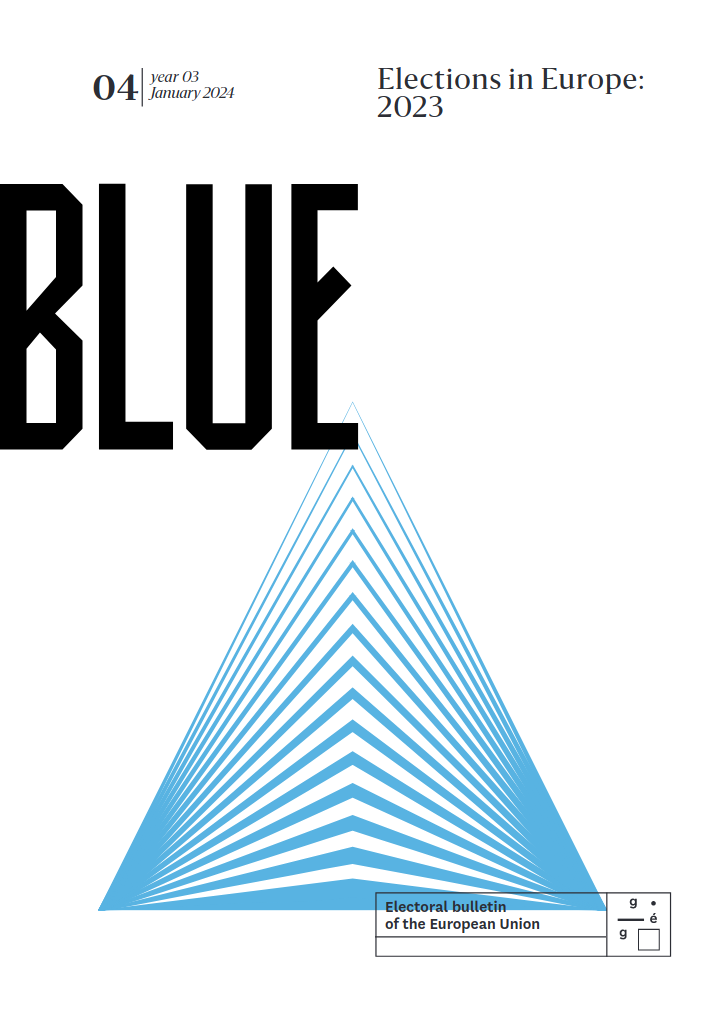
Issue 4, January 2024
Elections in Europe: 2023
Context of the vote, election campaign
On the eve of the 2022 Italian general election, the regional president of Latium (Lazio), Nicola Zingaretti, had been in office for two consecutive five-year terms since the resignation of Renata Polverini in 2012 following a series of scandals. From 2019 to 2021, the prominent centre-left leader had additionally been the national secretary of his Democratic Party (Partito Democratico, PD, S&D), a charge from which he eventually stepped down in the wake of growing internal tensions. In September 2022, Zingaretti was elected deputy for the Lazio 1-01 constituency and withdrew from regional politics, being succeeded ad interim by Daniele Leodori.
In the 2023 regional election, the centre-left nominated Alessio D’Amato, who had been the health councillor of Zingaretti’s regional administrations, as its presidential candidate. The hope of the left-wing coalition was that D’Amato’s leading role in managing the coronavirus pandemic in the Latium region and the success of the vaccination campaign he conducted would have garnered a positive opinion about him. The right-wing coalition, on the other hand, chose a candidate with no previous experience in office: Francesco Rocca, a former president of the Italian Red Cross and president of the International Federation of Red Cross and Red Crescent Societies. The third major presidential candidate was journalist and TV anchor Donatella Bianchi, who was nominated by the Five Star Movement (Movimento 5 Stelle, M5S, NI).
While in Lombardy the PD and M5S both supported the same presidential candidate (Pierfrancesco Majorino), no comparable coalition agreement was achieved in Latium. However, the centrist list of Azione and Italia Viva (Action-Italy Alive, Az-IV, RE) joined the centre-left coalition in supporting D’Amato — unlike in the 2022 general election, when it had run on its own. Other members of the left-wing coalitions included the centrist pro-EU party +Europa (+E, RE) as well as several left-wing and Green lists (Verdi Sinistra, Europa Verde, Possibile, Demos, Partito Socialista Italiano).
The right-wing coalition supporting Rocca consisted of the far-right Brothers of Italy (Fratelli d’Italia, FdI, ECR) and League (Lega, ID) together with Berlusconi’s Forza Italia (FI, EPP) and a few minor centrist lists (Unione di Centro and Noi Moderati). This alliance mirrored the winning coalition of the previous parliamentary election in September 2022, in which Giorgia Meloni’s FdI emerged as the largest party (Plescia and Marini 2023). Finally, the third candidate, Bianchi, was supported by the M5S and another small leftist list.
Due perhaps to its being held shortly after the snap election in Autumn 2022, the electoral campaign was rather short and underwhelming. The lack of sensational events might in turn have contributed to a low mobilization. The main topic touched upon by the campaign was public health. Public health is a policy area in which Italian regions enjoy a high degree of autonomy from the central State and can manage significant public funds. On the other hand, the public-health background of the two main candidates brought health issues further to the fore, with D’Amato highlighting the strengths, and Rocca the flaws of Latium’s health service. Another hot issue was the project of a waste-to-energy plant in the outskirts of Rome, which had been championed by the mayor of Rome Roberto Gualtieri elected from the centre-left lists in October 2021 (Marini 2022). In line with their respective parties’ positions, D’Amato endorsed the incinerator project while Bianchi strongly opposed it. Rocca’s stance appeared more blurred.
Analysis of the results
The electoral system has been unchanged since 2018. Each voter can select a candidate for president as well as a list, regardless of whether the list supports this candidate or not (split vote). Selecting only a presidential candidate is allowed, in which case no list vote is counted. Voters can also select a list only, leading to a vote for the associated presidential candidate being automatically counted. Of the 50 regional councillors, 40 are elected by proportional representation (Hagenbach-Bischoff system) from provincial lists on the basis of the list votes. Most of them represent the constituency of Rome (29), with 4 each for Frosinone and Latina, 2 for Viterbo and only 1 for Rieti. The president is elected directly in a first-past-the-post system on the basis of the presidential votes, while the presidential candidate that obtains the second-largest vote share obtains a seat as councillor. Finally, 10 seats are distributed between the parties and coalitions supporting the winning candidate to ensure, if possible, a majority of at least 60% of the seats to the elected president.
At the time of Zingaretti’s reelection in March 2018, the electoral competition in Latium was structured around 3 main poles of roughly similar strength: Zingaretti’s centre-left gathered just below 33% of the votes; the centre-right, slightly above 31%; and the Five Star Movement around 27%. In the course of the following 5 years, however, the balance of forces changed dramatically.
Shortly before the vote in February 2023, polls indicated a clear 5 to 10-point lead for the right-wing coalition over the left-wing coalition. Rocca was expected to gather slightly more than 40% of the vote, D’Amato between 30 and 35%.
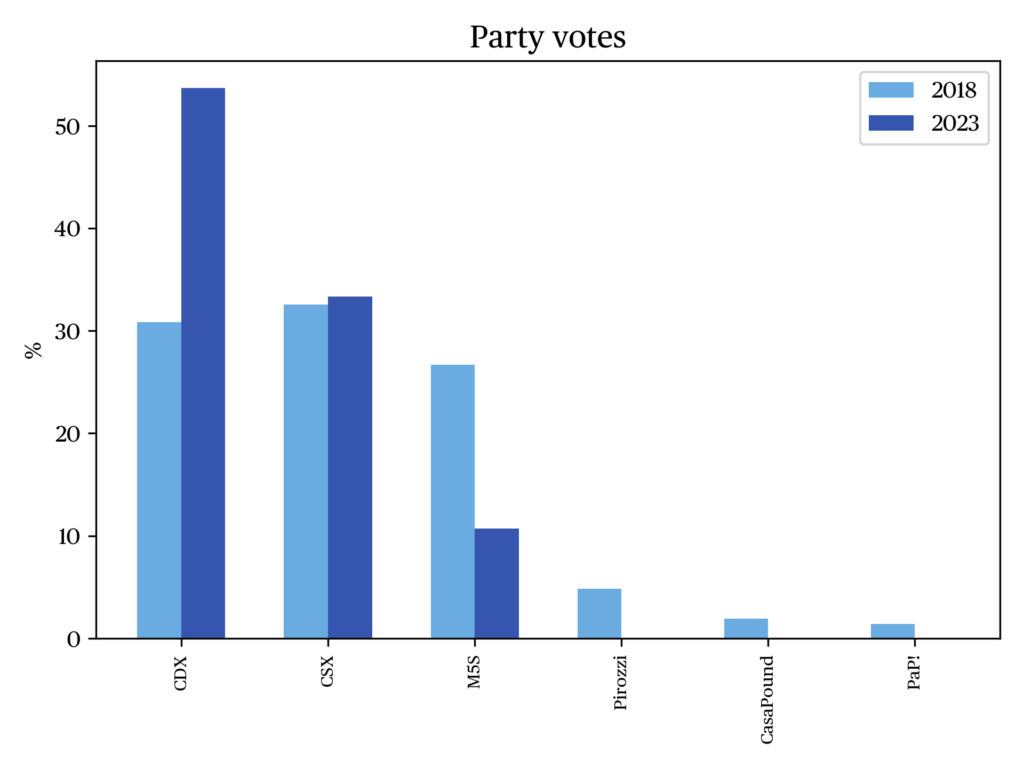
CDX = centre-right, CSX = centre-left
Although this general pattern was indeed correctly predicted, the right-wing coalition eventually gathered way more support than predicted by the polls, falling short of 54% of votes. D’Amato obtained 33.5% and Bianchi 10.8% — leading to a significant change in the balance of power compared to the 2018 results. The largest party was FdI with 33.6% of the votes (an impressive increase compared to the 8.7% it had obtained in 2018) followed by PD with 20.4% (a minor loss compared to its 21.25 in 2018). The League, Forza Italia and the M5S all gathered around 8.5% each, while Azione-Italia Viva secured just 4.9%.
| Coalition / List | Rome 2022 general | Rome 2023 regional | Latium 2022 general | Latium 2023 regional |
| Centre-right | 488992 (37%) | 352199 (46%)✝ | 1214696 (45%) | 936388 (54%)✝ |
| FdI | 357821 (29%) | 214238 (33%) | 841507 (31%) | 520731 (34%) |
| Lega | 54130 (4%) | 28298 (4%) | 175611 (6%) | 131811 (9%) |
| FI | 56643 (5%) | 29563 (5%) | 183587 (7%) | 130566 (8%) |
| Centre-left | 424041 (32%) | 305438 (40%)✝ | 722129 (27%) | 581974 (33%)✝ |
| PD | 290527 (23%) | 145286 (22%) | 523128 (19%) | 313658 (20%) |
| Az-IV | 129856 (10%) | 37751 (6%) | 225943 (8%) | 75306 (5%) |
| M5S | 174329 (14%) | 64510 (10%) | 406332 (15%) | 132267 (9%) |
| Valid votes (coalitions) | 1250997 | 766908✝ | 2709956 | 1737545✝ |
| Valid votes (lists) | 1250997 | 647522 | 2709956 | 1548288 |
Figure b · Electoral results
These results gave rise to a regional council dominated by FdI, who now holds 22 of the 51 seats. The Democratic Party secured the second largest representation with 10 seats, while 3 seats were won by each of FI and the Lega. Another 2 seats went to lists supporting Rocca, for a total of 30 seats to the right-wing coalition; 4 seats went to other lists supporting D’Amato (14 in total for the centre-left); and a total of 5 seats went to the M5S and the other list supporting Bianchi.
But the most striking result concerned voter turnout: in all provinces, abstention reached record levels, with a turnout of just 37,2% at the regional level, falling to as low as 33,11% in the municipality of Rome. Figure 3 below shows the drops in participation by province, as well as in the region as a whole.
In relative terms, the comparison with the 2022 general elections shows a moderate increase in the vote shares of the individual parties of the centre-right and the centre-left and a significant decline of the two non-aligned parties, the M5S and Azione-Italia Viva, who both lost around 40% of their vote share. But due to the very low turnout, a different picture emerges when considering absolute numbers: the number of voters of the two main coalitions decreased by 20% (centre-left) and 25% (centre-right), while M5S and Azione-Italia Viva lost two-thirds of their voters compared to their 2022 election shares. Not unlike previous elections (Carrieri 2018), the regional ballot seems to have benefited the two traditional political camps, which have suffered to a lesser extent from the demobilisation of their electorates. However, the overall trends remain in line with national dynamics: the right is strengthened, the centre-left stable, the M5S crumbles, and centrist Azione-Italia Viva loses momentum.
Voter transitions
The dramatic changes in the vote shares of the centre-right (+23 pp) and the M5S (-16 pp) in a high-abstention context call for a more fine-grained analysis of voter transitions. As detailed survey data is not available for the election under scrutiny, we use a multinomial-Dirichlet ecological inference model (King 1997, Rosen 2001) trained on municipality-level data to compute estimates of the transitions. To obtain more reliable results (Plescia & De Sio 2018), we focus on transitions between the three main coalitions, non-voters, and other political parties.
The results of our model suggest that the observed changes result from the combination of three phenomena: (a) the massive abstention of former M5S voters; (b) the centre-left losing voters to the centre-right, non-voters, and (to some extent) the M5S; and (c) the right’s ability to compensate the demobilization of part of its electorate through moderate gains from the left. These results contradict the narrative of a sudden “swing to the right” in Latium in the wake of Meloni’s nationwide success: the Latian election instead saw a loss of support for all coalitions, including the center-right coalition, a loss that the right was able to successfully offset thanks to a limited influx of new voters coming from the center-left. At the same time, the M5S electorate collapsed, thus mechanically increasing the vote share of the remaining two coalitions. In the end, the coalition who had best succeeded in containing its losses celebrated a landslide victory, while a left-wing coalition suffering major absolute losses could nevertheless stabilize its vote share — but lost any opportunity to govern — due to the crumbling position of its only potential ally.
Geographical analysis
Among all Italian regions, Latium stands out for its being demographically dominated by a single municipality, Rome, which concentrates about half of the region’s registered voters. In total, 2,4 million voters (49%) are registered in the municipality of Rome (comune di Roma), another 1,1 million (24%) in the surrounding Province of Rome (provincia di Roma), with the remaining 1,3 million (27%) residing in the four other provinces of Viterbo (North-West), Rieti (North), Frosinone (South-East), and Latina (South).
The electoral scores of the parties display clear geographical patterns. The centre-left’s strongholds are the provinces of Rome (36%) and Frosinone (South East, 34%), with left-wing parties performing better in the city of Rome (39%) than in neighbouring municipalities. While also winning in Rome as well as the overwhelming majority of the region’s other municipalities, the centre-right obtains a lower share of votes in the Italian capital (46%) than in the Province of Rome (50%), and a lower share of votes in the Province of Rome than in the other four provinces. In fact, Rome is one of the region’s few municipalities where the right does not obtain a majority of the vote. On the other hand, in the province of Latina (South), where it is strongest, the centre-right gathers 67% of the vote. As for the M5S, the pattern of voter distribution following the 2023 election is even clearer: the party is stronger in Rome (12%) and its province (11%) than in the four other provinces, where it scores only 8-9% on average. This is in contrast with its performance in the 2018 election when the party achieved good results in most of the provinces, except Rieti. While turnout did not exceed 45% in any province, the very low electoral participation in the city of Rome (33%) favoured parties with better results outside of the capital.
Within the coalitions, the geographical distribution of the vote is more complex. As a detailed inquiry would go beyond the scope of this study, we only underline a few important facts. The centre-left coalition is dominated by the PD, which concentrates about two-thirds of the vote. Among smaller parties, the left-wing environmentalist Verdi e Sinistra (AVS, Greens/EFA, 2.7%) and centre-left DemoS (S&D, 1.1%) and +Europa (+E, RE, 1.0%) heavily rely on the electorate of the city of Rome, which provides 60%, 66%, and 61% of their voters respectively. On the right side of the political spectrum, the situation is more contrasted: while FdI achieves good results in all provinces (from 28% in Frosinone to 39% in Viterbo, including 36% in Rome), the Lega and FI are more dependent on their local strongholds. This is particularly clear for Matteo Salvini’s party, which reaches 23% in the Province of Rieti but only 6.7% in the Province of Rome (and 4.3% in the city of Rome), while obtaining figures as high as 60% in some smaller cities such as Borgorose (Province of Rieti). Forza Italia also performs poorly in Rome (4.6% in the city, 6.1% in the province) but reaches up to 20% in the Province of Latina, where it obtains particularly good results in the South-Eastern area.
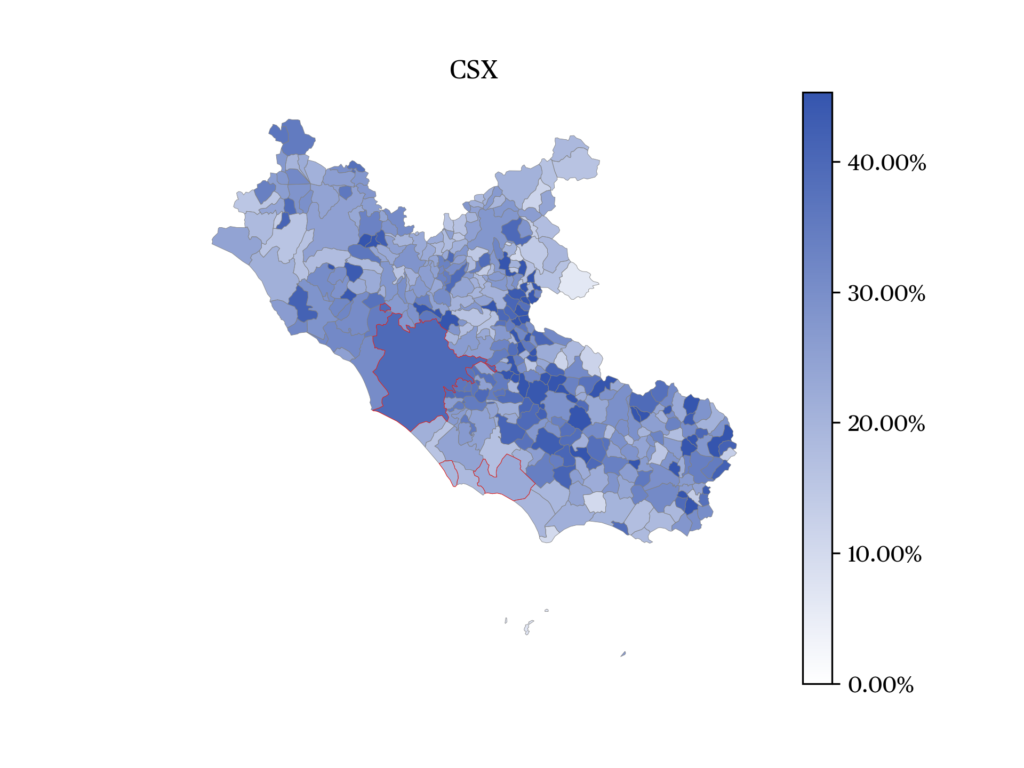
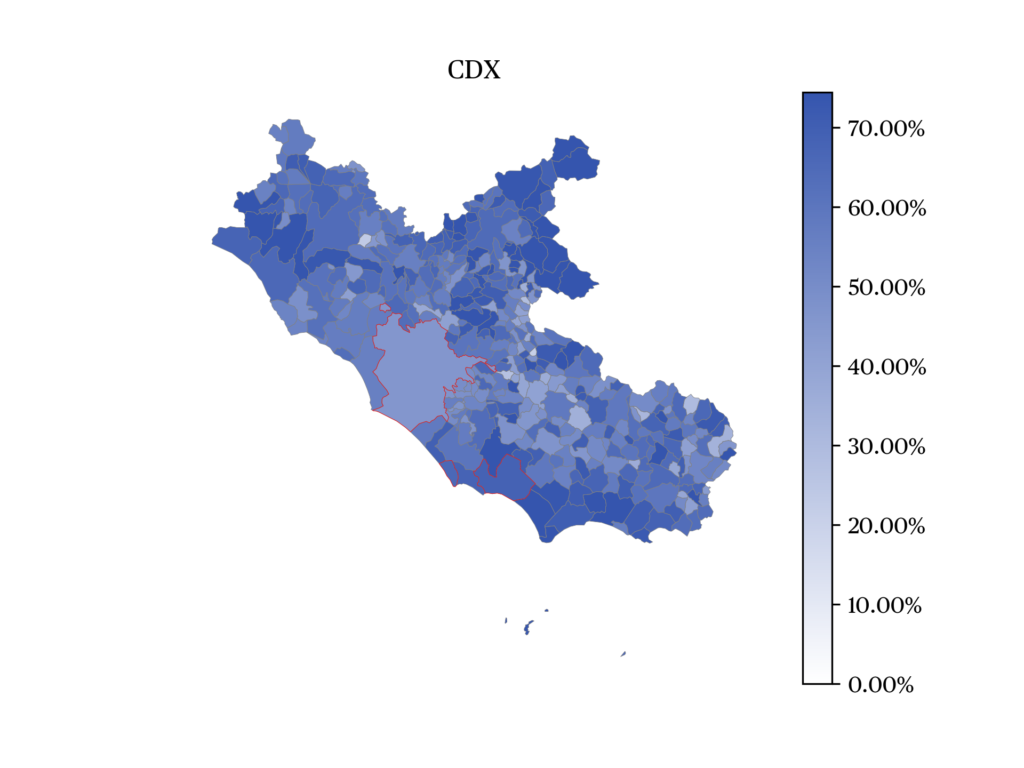
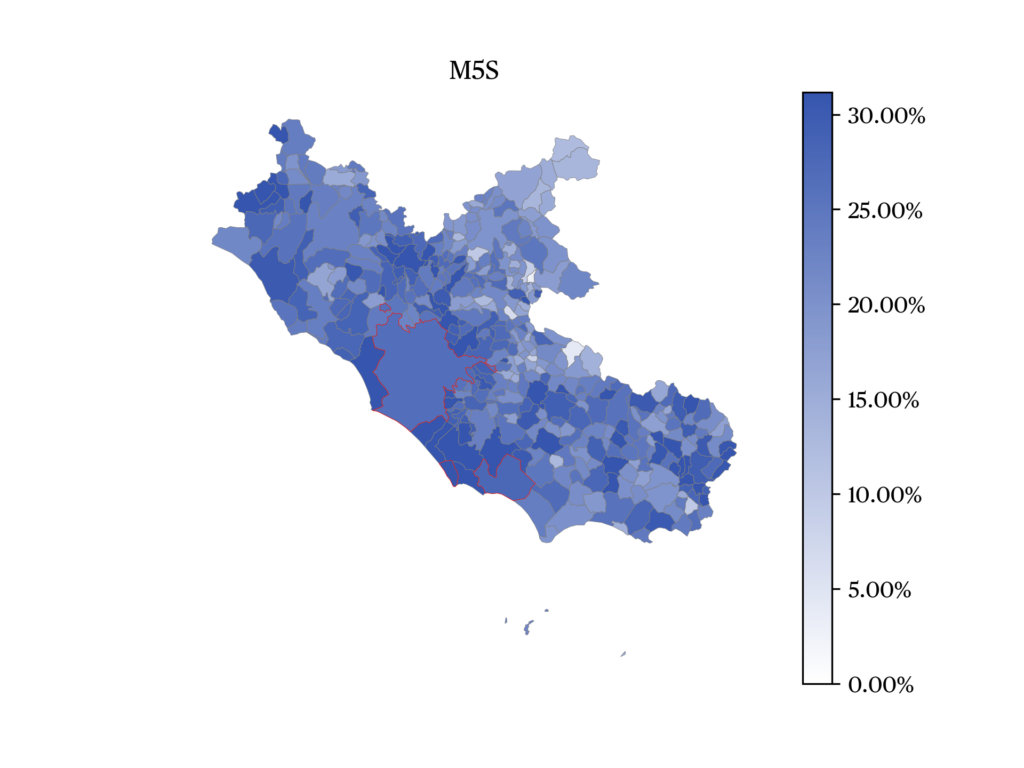
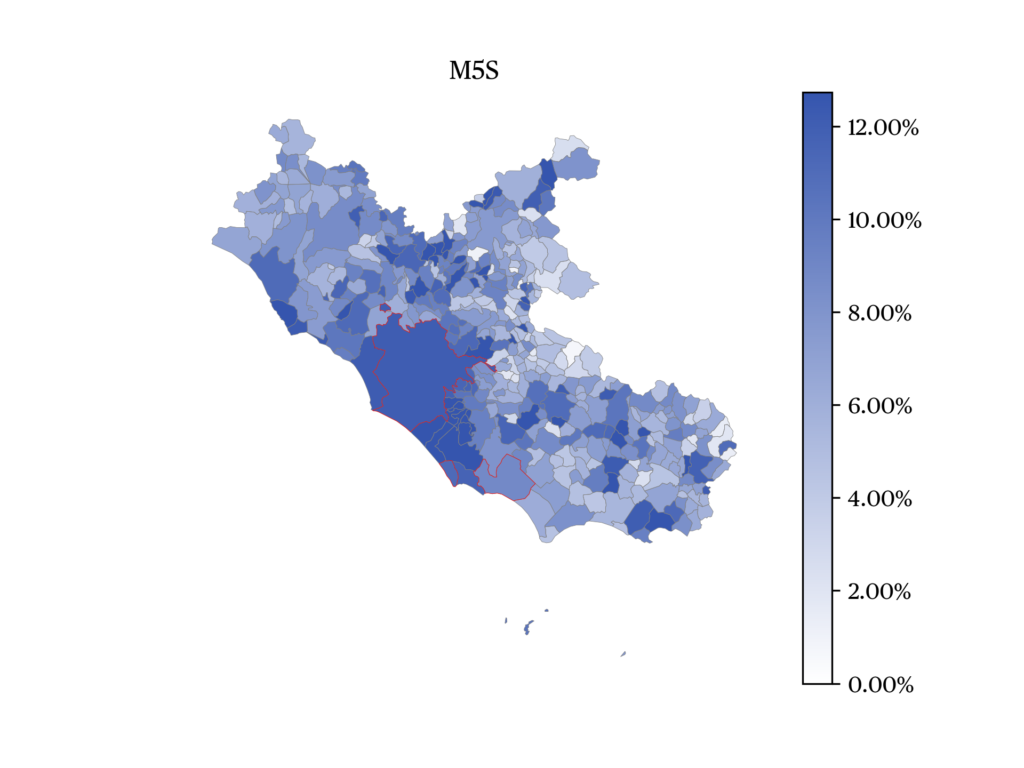
Executive formation and conclusion
On March 12, the new Latian regional executive (giunta regionale) was officially presented by its president Francesco Rocca. Besides Rocca, who was running as an independent, the government is composed of 10 councillors (assessori) with specific portfolios: 6 FdI members, 2 FI members, and 2 Lega members, a distribution that mirrors the parties’ respective vote shares and establishes FdI’s dominance over the regional executive. The new giunta’s vice-president is Roberta Angelilli (FdI, ex-FI), a long-time member (1994-2014) and ex vice-president (2009-2014) of the European parliament for the EPP, who now holds the key regional portfolio of economic affairs. Among the 10 councillors are 5 men and 5 women, of which three are former MEPs, four are former members of the regional assembly, and two are former mayors or vice-mayors. Together, they represent four of the five provinces in the region.
The President retained the health portfolio, despite some concerns of potential conflicts of interest due to his past positions in the administration of several hospitals. During its first few months in office, Rocca’s regional executive has put a strong emphasis on health issues. The executive announced additional investment in hospital equipment, monitoring systems, new hospital beds, and the reopening of health facilities, including using European funds from the Next Generation EU facility. The plan also involves new permanent contracts for hospital staff and better salaries for doctors. In its social and cultural policies, the Rocca executive has followed a markedly conservative and traditionalist agenda, withdrawing its support for the Rome Pride (which it claimed “supported” gestational surrogacy) while creating a “baby bonus” aid to new mothers aimed at boosting birth rates in the region; the close relationship of some top executives to notorious far-right figures has also sparked controversy. But as the regional budget suffers from a significant public deficit that Rocca’s ambitious investment plan is unlikely to alleviate, financial issues could become the new majority’s greatest political challenge — the deficit of the regional health sector, which amounted to about €200 million by end of 2022, is expected to increase more than three times in 2023.
The Data
Lists
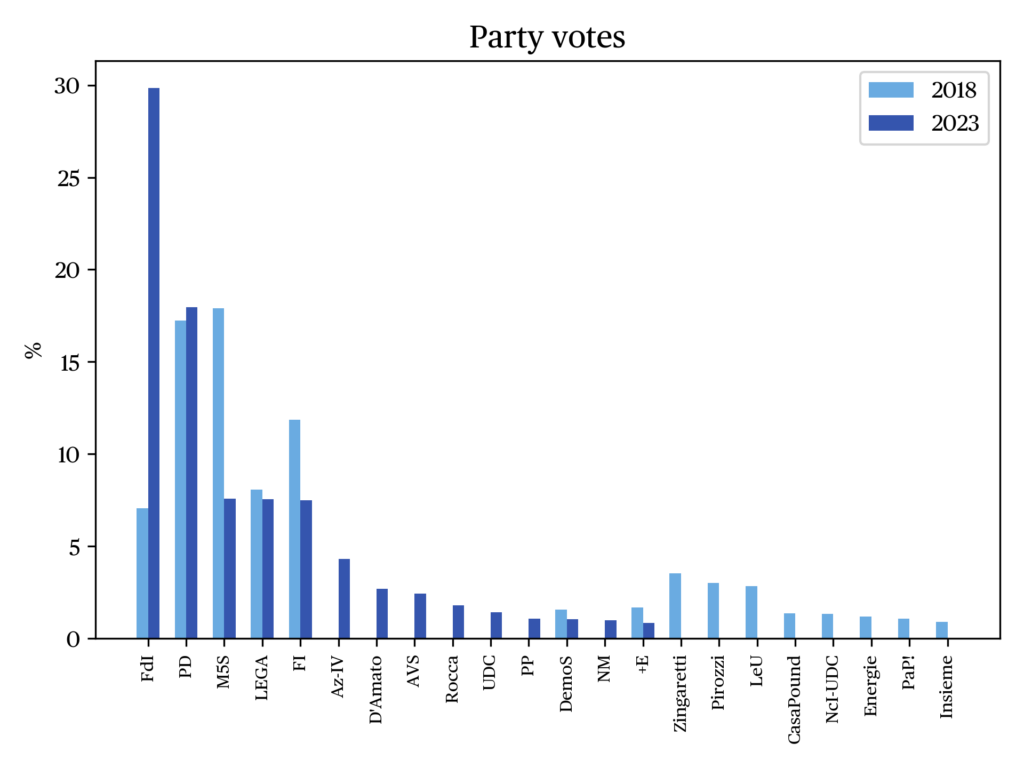
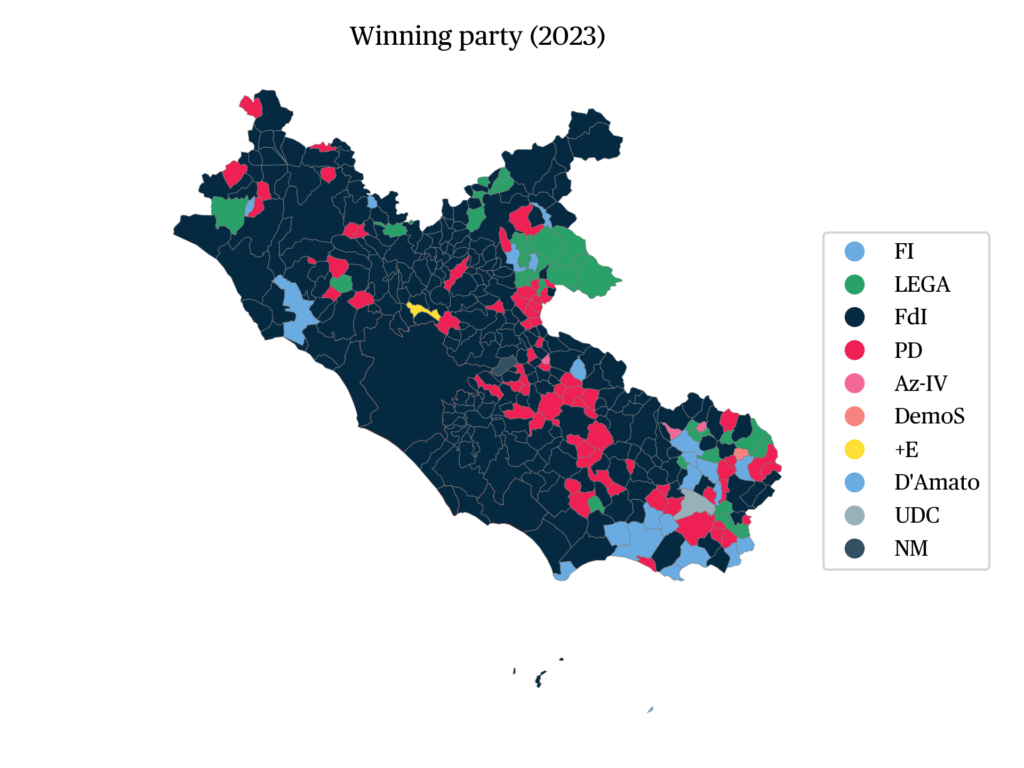
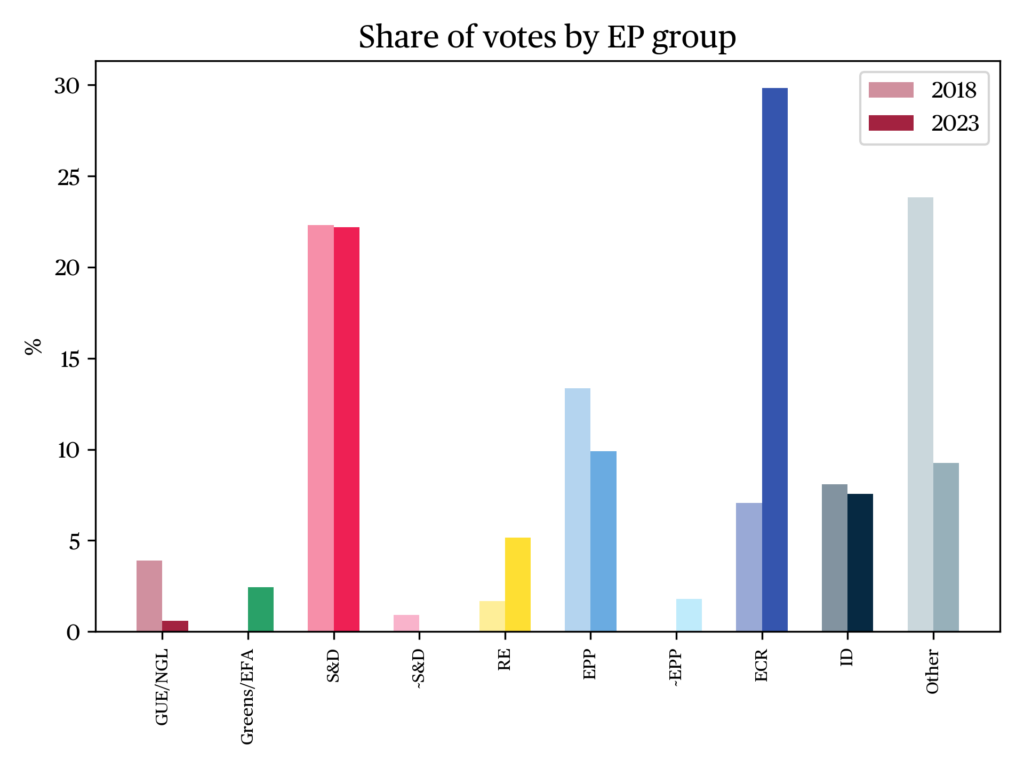
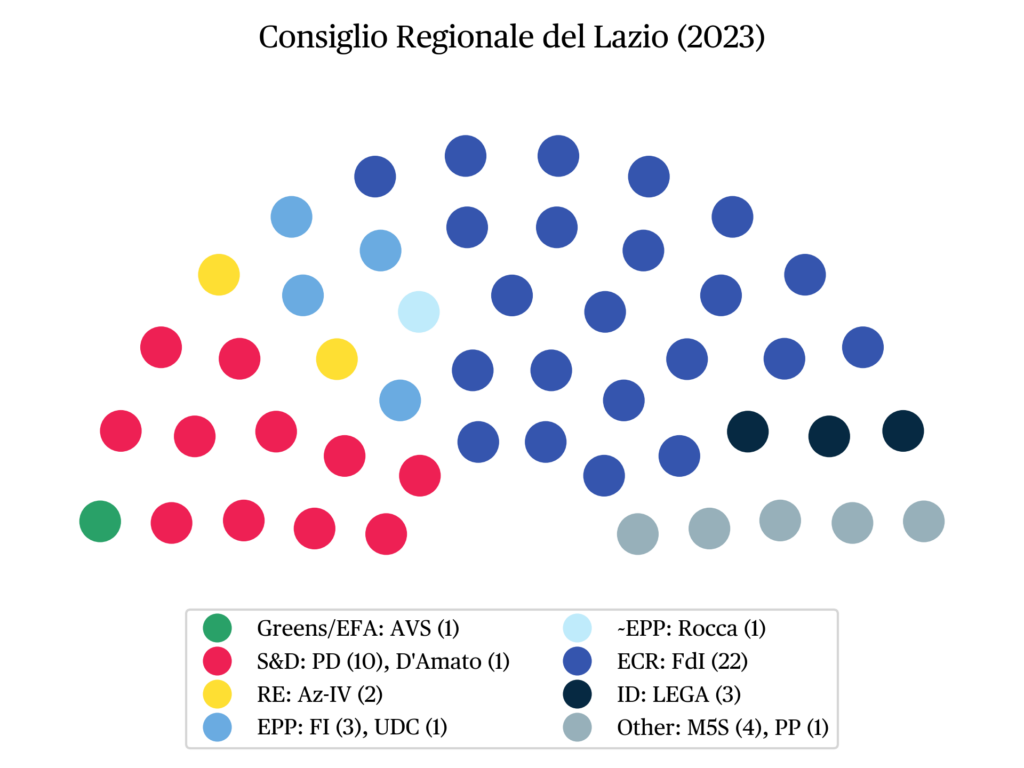
Coalitions

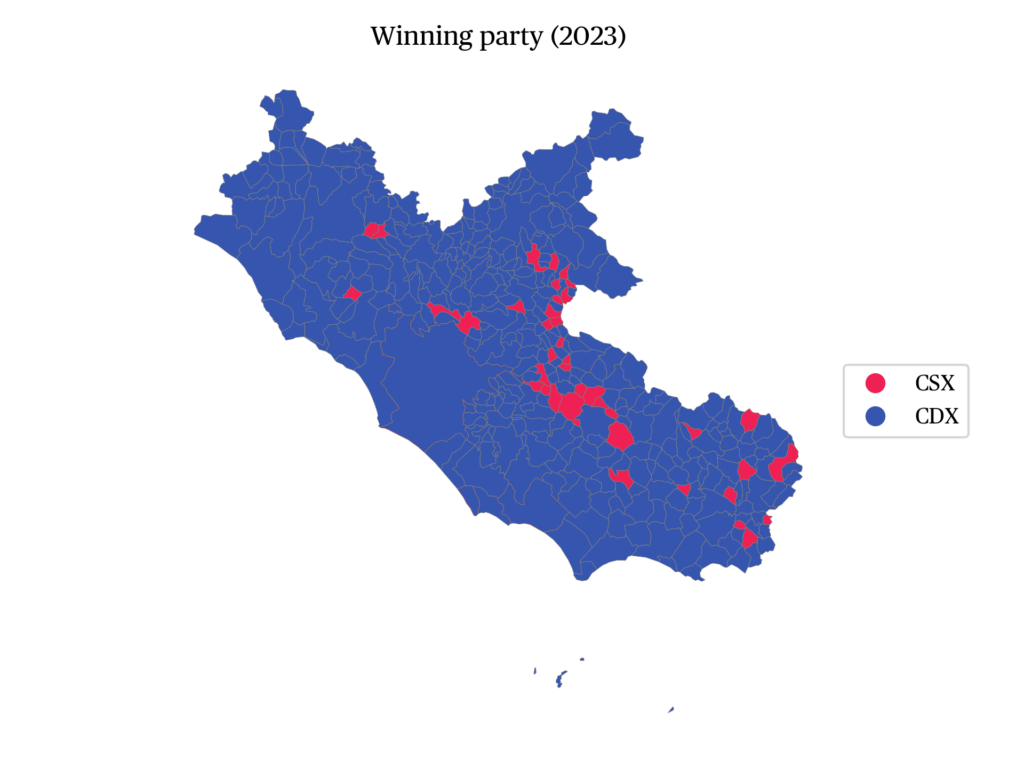
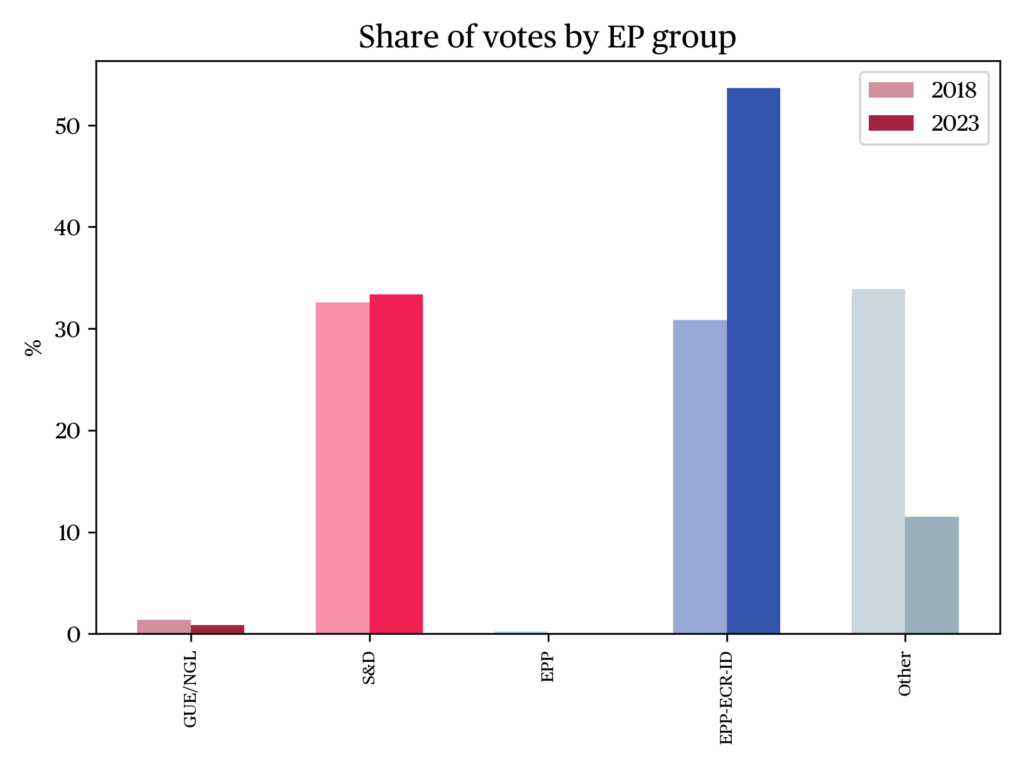
References
Carrieri, L. (2013). Le elezioni nel Lazio. In De Sio, L., Cataldi, M., & De Lucia, F. (eds), Le Elezioni Politiche, Dossier CISE 4 (pp. 161-164). LUISS University Press.
Carrieri, L. (2018). Regionali nel Lazio: l’effetto Zingaretti e le divisioni del centrodestra. In Gli sfidanti al governo. Disincanto, nuovi conflitti e diverse strategie dietro il voto del 4 marzo 2018, Dossier CISE 11 (pp. 167-171). LUISS University Press.
Grimaldi, S. (2021). Dal Bipolarismo al Tripolarismo e ritorno? Le Elezioni Regionali del ciclo 2018-2020. Regional Studies and Local Development, 2(1), 11-42.
King, G. (1997). A solution to the ecological inference problem: Reconstructing individual behavior from aggregate data. Princeton University Press.
Maggini, N., & Cataldi, M. (2018). Le elezioni politiche e le elezioni regionali del 2018. Quaderni dell’Osservatorio elettorale, 79(1), 127-149.
Marini, S. (2022). Italian municipal elections (Rome and Milan). Electoral Bulletin of the European Union (BLUE), 2, 158-162.
Plescia, C., & De Sio, L. (2018). An evaluation of the performance and suitability of R× C methods for ecological inference with known true values. Quality & Quantity, 52, 669-683.
Plescia, C., & Marini, S. (2023). Parliamentary election in Italy, 25 September 2022. Electoral Bulletin of the European Union (BLUE), 3, 109-113.
Rosen, O., Jiang, W., King, G., & Tanner, M. A. (2001). Bayesian and frequentist inference for ecological inference: The R×C case. Statistica Neerlandica, 55(2), 134-156.
citer l'article
Sofia Marini, François Hublet, Regional election in Latium, 12-13 February 2023, Nov 2023,
à lire dans cette issue
voir toute la revue





